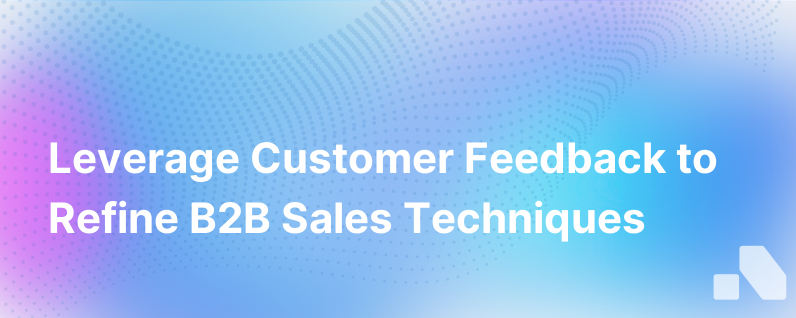The Importance of Customer Feedback in Refining B2B Sales Techniques
Published on December 29, 2023 by David Zhang
In the competitive landscape of B2B sales, the difference between stagnation and growth often lies in the company's ability to listen and adapt according to its customers' needs and feedback. The power of customer feedback for enhancing B2B sales techniques cannot be overstated. By harnessing insights from your client base, you can refine your sales approach, foster stronger relationships, and, ultimately, secure a more robust bottom line.
The Vital Pulse: Customer Feedback
At its heart, customer feedback serves as a pulse check for the business. It delivers impartial views on your products, services, and your sales process—from initial outreach and consultation right through to the closing of a sale and post-sale support. Essentially, feedback can serve as a roadmap, guiding the optimization of your sales strategies for better alignment with customer demands and expectations.
360-Degree Sales Refinement
From a B2B perspective, customer feedback must inform every aspect of the sales cycle. Rather than being reactive and only responding to overt dissatisfaction, proactive solicitation and utilization of feedback can turn an average sales operation into a powerhouse. It’s about:
- Understanding Needs: By listening to your customers, you gain valuable insights into their business challenges and opportunities, allowing you to tailor your offering more effectively.
- Continuous Improvement: Businesses that adopt a growth mindset and treat feedback as a loop can consistently enhance their solutions and sales strategies, keeping them relevant and aligned with market needs.
- Building Trust and Credibility: When customers see that their feedback is not just heard, but acted upon, trust flourishes. This not only retains current clients but also attracts new ones.
Leveraging Feedback Effectively
However, the mere collection of feedback is not enough. Effective utilization involves a multifaceted approach:
- Surveys and Questionnaires: Use these tools not just post-sale, but at various checkpoints during the sales process to understand evolving customer sentiment.
- Sales Call and Meeting Debriefs: Incorporate feedback requests as a natural part of your sales discussions. This not only provides real-time insights but also strengthens the customer relationship.
- Sales Analytics: Pair quantitative data from sales results with qualitative feedback to discern patterns and identify what’s working and what’s not.
Amplifying the Voice of Customers in Strategy Development
Strategy cannot exist in a silo. Sales strategies should be influenced by customer feedback in several ways:
- Personalization: Refining your approach to target specific industries and individual business pain points.
- Value Delivery: Ensuring your value proposition directly addresses known client needs and challenges.
- Product Development: Aligning product enhancements with customer feedback to offer solutions that truly resonate with the market.
Breaking Down the Feedback
Utilize tools and systems that can digest feedback into actionable insights, such as:
- Data Analysis: Use AI and other data analytics platforms to identify trends.
- CRM Integration: Ensure feedback is captured and associated with customer profiles for a holistic customer view.
- Actionable Reporting: Create reports that translate feedback into specific, actionable items for the sales team.
Engagement: The Feedback Catalyst
To harvest rich and honest feedback, engagement strategies need to be in place:
- Incentivize Feedback: Make providing feedback mathematically worthwhile for customers.
- Build a Feedback Culture: Make sure that requests for feedback are integrated naturally into the customer journey.
Challenges and Pitfalls
Navigating feedback is not without its challenges:
- Bias and Misrepresentation: Not all feedback is created equal. Parsing out anomalies from genuine criticism or praise is crucial.
- Volume Management: The sheer amount of data can overwhelm unless managed and categorized effectively.
Feedback as a Sales Training Tool
An often-overlooked advantage of customer feedback is its role in sales training and personnel development:
- Sales Approaches: Amending pitches and engagement tactics based on what resonates best with clients.
- Case Scenarios: Real customer feedback provides tangible, relatable scenarios for sales training.
- Product Knowledge: Feedback on products can be a knowledge goldmine for sales representatives.
Implementing Feedback-Driven Changes
The final and crucial step is driving changes based on the feedback:
- Feedback Review Meetings: Regularly scheduled meetings should parse through feedback and develop action points.
- Change Management: Adequately support your sales team as they adapt to new strategies informed by customer input.
Conclusion
In the B2B sales environment, customer feedback is not just a box to be ticked—it’s a powerful engine for continuous improvement, personalization, and versatile strategy development. By crafting a culture that values and systematically incorporates customer feedback, B2B sales teams can refine their techniques, offering proposed solutions that are as dynamic and nuanced as the clients they aim to serve. While Aomni provides the tools to harness customer feedback effectively, it acts as a partner in a journey towards sales excellence driven by customer-centric realizations, fostering a fertile landscape for business growth.
Sources:
- Customer Feedback Best Practices: Tips for B2B
- The Game-Changing Impact of Customer Reviews on B2B Sales
- How to Improve B2B Customer Feedback with Quality Insights
- Using Customer Feedback to Drive B2B Digital Product Development
- How to Get Started with B2B Customer Feedback
- Learn about the most common customer feedback challenges and how to overcome them with tips and strategies for after-sales success.
- How Case Studies help to attract new customers in B2B sales
- Why Customer Feedback is Important for B2B